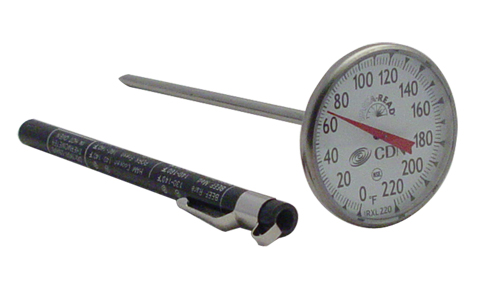Maintaining proper food temperature should be a constant process in your commercial kitchen, from the time it arrives through your back door to the time it arrives on the customer’s plate.
 When the delivery truck arrives, immediately check food products for temperature. Reject food that arrives above 41 degrees Fahrenheit. Once you have ensured that the food has arrived in good condition, store it immediately.
When the delivery truck arrives, immediately check food products for temperature. Reject food that arrives above 41 degrees Fahrenheit. Once you have ensured that the food has arrived in good condition, store it immediately.
Use a good thermometer. Make good thermometers available to your staff to help with the temperature monitoring process. Make sure you and your staff are trained in proper thermometer use:
Insert the thermometer into the thickest part of what you want to measure, and make sure the tip is in about the center.
Wait about five minutes for a proper reading. Newer digital thermometers will beep when they have reached the absolute temperature.
Sanitize the thermometer before and after each use.
Constantly monitor food temperatures. Develop and post a temperature monitoring schedule for all the different food types you are currently storing and prepping.
Train other employees to help you maintain this schedule. Stay out of the food temperature danger zone between 41 degrees and 145 degrees Fahrenheit.
For heated foods, post a safe temperature chart for cooked foods and train your employees to properly use a thermometer to check food temps during heating.
Safe Chilling and Heating Instructions
Keeping out of the 41 degrees to 145 degrees danger zone should be the top priority for all foods and ingredients. The one exception to the danger zone rule is freshly cooked food, which can be held at 140 degrees before serving, although you should establish a deadline for hot held food after which you should either rapidly chill and store the product or dispose of it.
If you are chilling food that was heated, chilling it rapidly is the best way to prevent bacterial growth. Use a blast chiller or a cold paddle to bring food temperature down quickly.
This also retains maximum food freshness. After food has been rapidly cooled, store it in a commercial refrigerator or freezer. Use storage containers to maintain freshness.
If you are serving cold foods, use a chill pan with built-in refrigerant and ice to ensure food maintains the correct temperature. Monitor temperature to make sure food items are not rising above 40 degrees Fahrenheit.
 Corner Booth Blog | TundraFMP Restaurant Supply, News & Equipment Blog
Corner Booth Blog | TundraFMP Restaurant Supply, News & Equipment Blog




It is crucial to teach your staff how to re-calibrate the thermometers that you use. These tools will eventually loose their accuracy, so constant check up on calibration is a great practice. I have also seen food service operators who will keep standard thermometers available to their staff as a back up to digital thermometers that operate off of a battery.
In a need to easily operate for daily HACCP checks, the latest and greatest quick and accurate measurement solution is infrared thermometers. The Comark/Fluke FoodProPlus is a combination of NSF -certified spot-illuminated infrared also with a probe for internal meat temperature. This tool is accurate and speedy for hot and cold stations. Some other procedure areas are: Receiving Department, Walk-Ins, Reach-ins, Hot & Cold food workstations, Fryer, Grill, and Oven. Online training is available at http://www.fluke.com/foodpro.
Steve is right. The FoodPro and FoodPro Plus are great thermometers. I had the pleasure of doing a demo on these thermometers at last year’s NEHA conference and the response was excellent.
Keeping out of the 41 degrees to 145 degrees danger zone should be the top priority for all foods and ingredients.